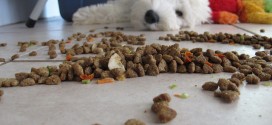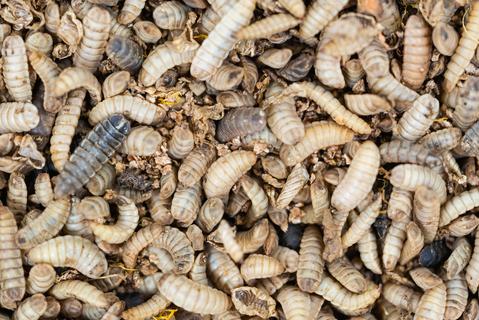文:美乐狗.千金爸
请兽医不要再说老狗要降低蛋白质摄取了!
请兽医不要再说高蛋白质会伤害肾脏!
其实很多年前这样的研究资料已经出炉,我们也曾经在网志上提出来过,奈何非常多的兽医并没有去钻研这样的资料,还停留在过去的假设认知当中,连知名兽医还在呼吁老狗要限制蛋白质以免肾脏出事(他也不是第一次造成误导了,在疫苗以及饲料的态度也都是如此昨是今非)。
根据NRC(美国国家科学研究委员会)揭示研究报告的幼犬生长期增重实验,如果喂食幼犬(14周龄)高品质且易消化的蛋白质,15公斤体重每日只要约45公克的蛋白质,但是如果喂食谷类、动物性副产品的蛋白质,所需要的蛋白质会更多,15公斤体重需要约62.5公克的蛋白质,高出将近40%。可见喂食狗儿高消化性的优质高蛋白质,可以吃得比较少,所产生的含氮代谢物也会比较少。
一直以来,兽医师认为老狗的饮食必须低蛋白质,但实际上的研究则不然。NRC 2006年出版的《犬猫营养需求报告书》中指出(注),老狗需要摄取更高的蛋白质(约比一般成犬高出50%),以维持最佳免疫反应、愈合伤口,并且确保老年时的健康。
注:1岁的狗儿每公斤体重每日需要2.5g蛋白质,12~13岁的狗儿每公斤体重每日需要3.75g蛋白质,Determination of Optimal Dietary Protein Requirements of Young and Old Dogs, R.W.Wannemacher,Jr. and John R. McCoy, Journal of Nutrition)
而以下来自犬猫营养学的专书(2010年出版的)
如果你的兽医还在这样讲,请把以下内容印给他看,文末有各项研究报告的索引,可以让兽医好好仔细查查并详加阅读:
==================================================================
文章来源:CANINE AND FELINE NUTRITION, THIRD EDITION (ISBN: 978-0-323-06619-8)
PROTEIN EXCESS IN DOGS AND CATS P.103~P.104
与普遍看法相反,没有任何研究、确实的证据认为蛋白质摄取会让健康的猫狗造成肾脏功能不全(kidney dysfunction)
没有任何证据证明年老的的宠物仅仅因为年纪大了而必须限制蛋白质的摄取。
—————————————————————————————————–
先前提到,有一些证据建议喂食动物较高于最低需求的蛋白质有助于维持含氮物平衡,如此全身蛋白质的流动可以借此让估算动物维持蛋白质需求时比较有利。
当摄入超过需求的蛋白质,有两种可能使用额外蛋白质(蛋白质中的氨基酸)的途径。
如果动物正处于消瘦的热量不足状态,过多的蛋白质会作为能量的来源
相反的,如果动物正处于适当的热量供给或是热量过多的状态,过多的蛋白质将会储存为脂肪,而且含氮物将会透过尿液排出。不像脂肪与碳水化合物一样,氨基酸是不能储存在身体中作为未来使用。
所有同伴动物都有能力代谢过多的蛋白质。这种代谢过程的结果是生成蛋白质尿素并随着尿液排出。
过去有理论认为蛋白质摄取超过动物所需对于肾脏功能有不利的影响,特别是在年老的动物。
这是基于分解过多蛋白质以及随后排出尿素的尿液以及其他含氮的废物会导致肾功能不全的理论。(注94 )
在动物慢性肾脏疾病以控制饮食中的蛋白质作为降低尿毒症以及其相关临床讯号,但没有任何证据显示蛋白质摄取引发或是帮助肾功能不全的发展。(注95)
随着动物的年纪,肾脏的重量会减少而且肾功能会逐渐衰减。
这些是正常发生的,而且在人类及老鼠身上已经有广泛的研究。(注96,97)
不过这些变化不应该过度扩大解释来建议需要降低饮食中的蛋白质。(注98 )
一项在13年期间以米格鲁群为样本来评估肾脏功能临床变化的研究,研究资料指出正常肾脏老化会在临床或生化讯号发生前就已经出现超过75%的肾损伤。(注99 )
动物在小于75%的损害前的临床信号经常是正常的。但是牠们或许比那些仍然蕴藏储备肾功能能量的年轻动物更容易感受到肾脏伤害。
这些知识引导到未经实务测试就系统性降低老年动物饮食中的蛋白质来尝试避免或是降低肾功能不全的发展。
不过,最近研究已经显示老狗确实可以从稍高品质的蛋白质以及增加饮食中的蛋白质来帮助改善由于年纪造成的肌肉质量的损失。(注100 )
因此,没有任何证据指出需要系统性降低健康老年宠物饮食中的蛋白质。
老年宠物不应该仅仅由于年纪逐渐老了而被限制饮食中的蛋白质。
==================================================================
原文:CANINE AND FELINE NUTRITION, THIRD EDITION (ISBN: 978-0-323-06619-8)
PROTEIN EXCESS IN DOGS AND CATS P.103~P.104
As discussed previously, there is some evidence suggesting that it may be beneficial to feed animals levels of protein that are higher than the minimum level necessary to maintain nitrogen equilibrium, and that whole-body protein turnover provides a better estimate of an animal’s maintenance protein needs.
When protein in excess of needs is consumed, there are two possible uses for the additional protein (amino acids). If the animal is in negative energy balance, the excess protein will be used as an energy source.
Conversely, if the animal is in zero or positive energy balance (i.e., consuming adequate or excess energy than it is expending, respectively), the excess protein will be deposited as fat and the nitrogen will be excreted in the urine.
Unlike fat and carbohydrate, excess amino acids are not stored by the body for future use.
All companion animals have the ability to metabolize excess protein. This process results in the production of protein urea and its excretion in the urine.
Historically, protein intake that was greater than an animal’s requirement was theorized to have detrimental effects on kidney function, especially in aging animals.
This was based on the theory that the catabolism of excess protein and subsequent urinary excretion of urea and other nitrogenous waste products was responsible for the progression of renal dysfunction.(注94 )
However, while the control of dietary protein is used to reduce uremia and its associated clinical signs in animals with chronic renal disease, there is no evidence showing that protein intake initiates or contributes to the progression of kidney dysfunction (see Section 5, pp. 412-414 for a complete discussion).(注95)
As animals age, they experience reduced renal weight and a gradual decline in kidney function.
These are normal occurrences and have been extensively studied in humans and rats.(注96,97)
However, these changes should not be extrapolated to suggest a need to reduce dietary protein.(注98 )
A study with dogs evaluated clinical changes in renal function in a colony of Beagles for a period of 13 years. The data from this study indicate that normal kidney aging can lead to a nephron loss of up to 75% before clinical or biochemical signs occur.(注99 )
Animals with less than a 75% loss are usually clinically normal,
but they may be more susceptible to renal insult than are younger animals still possessing renal reserve capacity.
This knowledge led to the untested practice of systematically reducing the protein content in the diets of elderly animals in an attempt to prevent or minimize progression of kidney dysfunction.
However, recent studies have shown that geriatric dogs actually benefit from slightly higher levels of high-quality protein and this increased dietary protein can help to ameliorate the age-associated loss of muscle mass.(注100 )
Therefore there is no evidence indicating a need to systematically reduce protein levels in the diets of healthy older pets. It is recommended that protein in the diets of geriatric pets should not be restricted simply because of advancing age (see Section 4, pp. 268-270 for a complete discussion).
—————————————————————————————————————————————-
Contrary to popular belief, there is no research-based, conclusive evidence that protein ingestion contributes to the development of kidney dysfunction in healthy dogs and cats.
Moreover, there is no evidence that the protein intake of geriatric pets should be restricted just because of old age.
—————————————————————————————————————————————–
(注94.)Murphy DH: Too much of a good thing: protein and a dog’s diet, Int J Study Anim Prob 4:101–107, 1983.
(注95.) Finco DR, Brown SA, Crowell WA, and others: Effects of aging and dietary protein intake on uninephrectomized geriatric dogs, Am J Vet Res 55:1282–1290, 1994.
(注96.) Lowenstein LM: e rat as a model for aging in the kidney. In Gibson DC, Adelman RC, Finch C, editors: Development of the rodent as a model system of aging, Washington, DC, 1978, US Department of Health, Education, and Welfare.
(注97.) Goldman R: Aging of the excretory system: kidney and bladder. In Finch EE, Hayflick L, editors: Handbook of the biology of aging, New York, 1977, Van Nostrand Reinhold.
(注98.) Milward DJ, Fereday A, Gibson N, Pacy PJ: Aging, protein requirements, and protein turnover, Am J Clin Nutr 66:774–786, 1997.
(注99. Cowgill LD, Spangler WL: Renal insu ciency in geriatric dogs, Vet Clin North Am Small Anim Pract 11:727–749, 1981.
(注100.) Davenport G, Gaasch S, Hayek MG, Cummins KA: Effect of dietary protein on body composition and metabolic responses of geriatric and young-adult dogs, J Vet Intern Med 15:306, 2001.
版权声明:阿公阿嬷碎碎唸http://www.murmurdnk.tw
(照片来源:![]()
![]() eschipul)
eschipul)
 阿公阿嬷碎碎唸(Murmur Denver & Karen) 一对拥有十二只狗女儿及狗孙子女,享受人狗一家的老夫妻平凡生活记趣。
阿公阿嬷碎碎唸(Murmur Denver & Karen) 一对拥有十二只狗女儿及狗孙子女,享受人狗一家的老夫妻平凡生活记趣。





